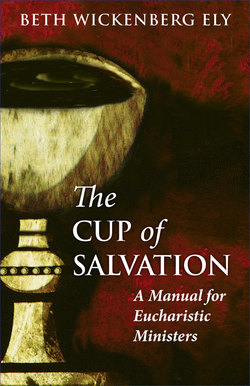Читать книгу The Cup of Salvation - Beth Wickenberg Ely - Страница 9
ОглавлениеArchaeology tells us that the chalices of early Christians primarily were of glass, though some were of ivory, wood, clay, and occasionally base and precious metals.
Early on, for their daily communion, bishops and priests used a different kind of chalice made from simple materials and shaped like those we have today. In the eucharist, they offered the laity (when they received, usually only at Easter and other high holy days) another type—the calices ministeriales. These very large chalices were designed to be seen from the back of churches and often had handles, such as this late fifth- or early sixth-century chalice (see photo overleaf).
Writing in the early 1900s, Roman Catholic historian Herbert Thurston, SJ, observed that the handles “would have afforded additional security against accidents when the sacred vessel was put to the lips of each communicant in turn. In a rude and barbarous age the practical difficulties of Communion under species of wine must have been considerable.”1
A very large chalice with handles found near Gourdon, France. (Wikipedia Commons)
Another ministerial vessel, the Chalice of Ardagh, discovered in 1868 in County Limerick, Ireland, is one of the most beautiful ever found. Seven inches high and nearly 9.5 inches in diameter, the bowl holds three pints! This cup, made from more than 250 main components, is silver alloyed with copper, and it is decorated with gold filigree, multicolored enamels, a large rock-crystal, amber, and malachite.2
Inscription of names of twelve disciples helps date Ardagh Chalice to eighth century. (National Museum of Ireland; Wikipedia Commons)
From the year 700 onward, much church legislation dealt with defining the proper materials for chalices and patens. It rejected simple wood chalices because their porous nature could trap the consecrated blood of Christ and never be totally cleansed. Cups made of horn, likewise, were not suitable because they were contaminated in their construction by the blood of the animal to which they originally belonged.
Later decrees went further, insisting that the paten and chalice be gold, or at least entirely of silver, or pewter for use with the poor. Brass and copper were forbidden because of the possibility of verdigris. Glass was ruled out, too, at one time.
“In the early ages of the Church, the priests were of goldand the chalices of wood, but now the chalices are of goldand the priests of wood.”Attributed to St. Boniface (c. 740) 3
Still later, the canons directed that the inside of bowls of silver chalices be gilded or given a gold wash. The bowls of pewter vessels, still permitted in “circumstances of great poverty or in time of persecution,” also were to be gilded.4
The design and workmanship of communion vessels became a high art. Many cups survive and are on display in cathedrals in the British Isles, Europe, and Asia Minor. Many cups still survive as testaments to the devotion of the patrons who commissioned them and the artists who crafted their visions in the most precious metals and gems the earth has to give.
Since 2003 the Roman Catholic Church has allowed dioceses in the United States to use “other solid materials that, according to the common estimation in each region, are precious, for example, ebony or other hard woods, provided that such materials are suited to sacred use and do not easily break or deteriorate.”5
Agate, gold and semi-precious stones enhance eleventh-century Chalice of Doña Urraca at San Isidoro de León in Spain. (By Locutus Borg [José-Manuel Benito Álvarez] [Own work] [CC-BY-SA-3.0 (www.creativecommons.org/licenses/by-sa/3.0)], via Wikimedia Commons)
Though The Episcopal Church has no canons dealing with the materials used to create our altar ware, our congregations take great pains to see that their chalices and other communion vessels are beautiful, well-polished, and suitable to the reverence of the occasion. In keeping with centuries of tradition, we still memorialize loved ones with gifts of wonderful artistry to be used in the eucharist.
WHAT IS A KNOP?
The chalice is made of four parts: the bowl, the stem, the base, and the knob. That knob on the stem of many chalices is also called a “knop” or a “nodus” or a “pommellum.” It was added to many cups to make them easier for the clergy to handle, particularly when the celebrant raises the chalice during the elevation at the eucharist.
This part of the chalice, often embellished with precious gems, became very prominent during the Middle Ages.
The King James Version of the Bible uses the word “knop” when describing the sacred lampstand crafted to stand before the Ark of the Covenant:
Three bowls made after the fashion of almonds in one branch, a knop and a flower; and three bowls made like almonds in another branch, a knop and a flower: so throughout the six branches going out of the candlestick.” (Exodus 37:19)
DEDICATING A CHALICE
In Anglican theology, church ornaments and furnishings—vestments, stained glass windows, altar cloths, crosses, service books, etc.—“are consecrated by being put to the use for which they were intended”6 and do not technically need to be blessed, consecrated, hallowed, or otherwise dedicated.
Knop design featuring church windows makes it hard for EM to hold. By Unknown from Poland Unknown (muzeumutracone.pl The Lost Museum [Public domain or Public domain], via Wikimedia Commons)
